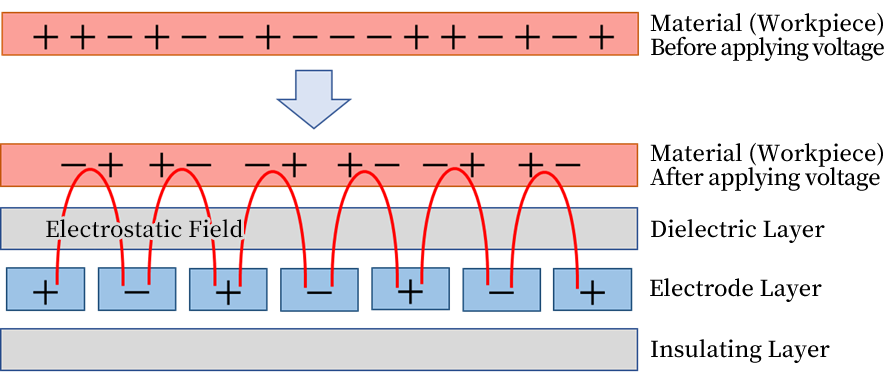- +49 (0)159 0653 1595
- CONTACT US

HOMEUnderstanding Electrostatic Chucking Principles
The chucking mechanism of electrostatic chucks (ESCs) is influenced by several electrical properties. Below, we introduce three types of chucking principles; however, it is important to note that these forces often work in combination rather than individually to achieve the chucking effect. At Creative Technology, we classify ESCs based on the question, “Which force is dominant?” Exploring the diverse chucking principles that vary depending on material and design remains one of our ongoing research focuses as a company specializing in ESCs.
①Coulomb Force
An ESC dominated by Coulomb force achieves reliable chucking by applying high voltage. This principle is highly effective for chucking conductive materials and is widely used in semiconductor manufacturing equipment. However, it is less suitable for non-conductive materials that are not easily polarized.
[Illustration of Coulomb Force]

②Johonson-Rabeck Force
An ESC dominated by the Johnson-Rahbek force achieves chucking by adjusting the insulating properties of the dielectric layer to allow a minimal current flow. When voltage is applied to the internal electrodes, charges gradually migrate to the surface of the dielectric layer, forming a virtual electrode. This virtual electrode is located very close to the material, enabling the ESC to generate high chucking forces even at low voltage levels.
[Illustration of Johnson-Rahbek Force]

③Gradient Force
An ESC dominated by the Gradient force utilizes the “electric field” generated between finely alternated positive and negative electrodes to chuck objects, making it particularly suitable for non-conductive materials. Non-conductive materials, which are less likely to polarize, are difficult to chuck using Coulomb or Johnson-Rabeck forces, requiring the use of an electric field to generate a force that forcibly attracts them. While reducing the distance between electrodes increases the chucking force, it also reduces durability between the electrodes, necessitating a balanced design.
[Illustration of Gradient Force]
